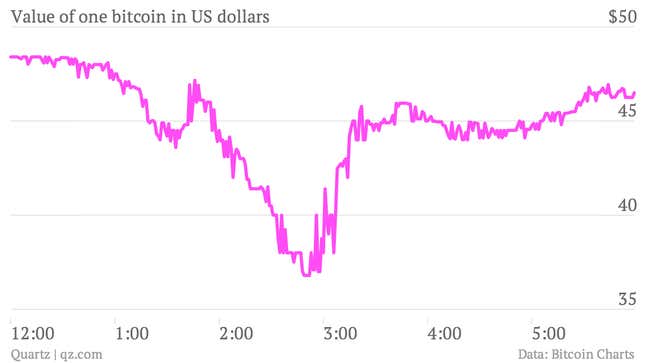
Bitcoin suffered a flash crash overnight, falling 22% in the span of an hour before returning to the record-high levels at which the alternative currency has lately been trading.
The cause was a software glitch. Bitcoin, which is operated as a collective with no central bank, recently upgraded its digital mint. Every 10 minutes, bitcoin “miners,” the people who create new units of the currency, compete to decrypt a puzzle that unlocks new bitcoins, which keeps the system running as it should. But it only works if everyone involved can agree the puzzle has been correctly solved.
Last night, bitcoin miners running the upgraded software disagreed with those running the previous version, grinding the mint to a halt and threatening to split bitcoin into two separate currencies. The market responded as it should, falling sharply to a low of $36.80 as the programmers who manage bitcoin considered their options. That the currency recovered so quickly—it’s trading at $44 right now—demonstrates the unflagging, perhaps undue, confidence of its investors.
The problem last night was resolved the way so many corporate IT departments deal with these kinds of mishaps: The software upgrade was rolled back. Merchants that accept bitcoins, which are numerous, are also being encouraged to suspend those transactions for now.
The flash crash highlights how bitcoin is at once unstable and resilient. The currency has suffered crashes before: It fell to $0 during a glitch two years ago, and hit a low of $2 during a sustained declined in 2011. But bitcoin rebounded in 2012 and has taken off in 2013, hitting new all-time highs, though experts I’ve spoken to recently are at a loss to explain the surge.